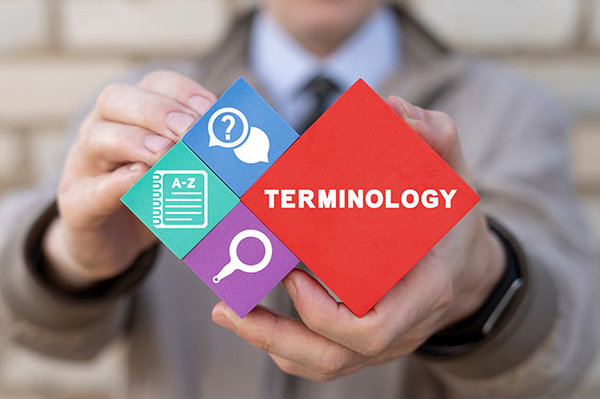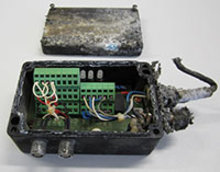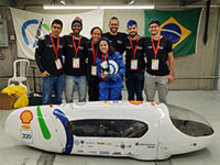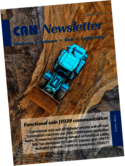
No. 11 - August 2, 2024
A word from the CiA Managing Director

The recently updated ISO 11898-2:2024 standard specifies CAN HS (high-speed) transceivers as well as CAN FD (flexible data rate) transceivers as in the ISO 11898-2:2016 standard. In general, there is no difference in these standards regarding these transceiver types. An exception is the definition for the dynamic symmetry parameters. Now, these parameters are guaranteed for the complete bit-rate range, which is specified in the transceiver product datasheet. For example, a lot of so-called 5-Mbit/s CAN FD transceivers are used at 2 Mbit/s. The intention behind, that the so-called 5-Mbit/s transceiver behaves at 2 Mbit/s as specified at 5 Mbit/s, is not covered in the ISO 11898-2:2016 standard. This modification will be explained in the updated CiA 601-1 technical report about CAN FD node and system design recommendations (revision is in preparation and comes soon).
Additionally, ISO 11898-2:2024 specifies the CAN SIC (signal improvement capability) transceiver, originally described in the CiA 601-4 specification (document has been withdrawn after releasing the ISO standard), and CAN SIC XL (extended data-field length) transceivers, deriving from the CiA 610-3 specification (has been withdrawn, too).
In order to avoid confusions, the following terms should be used to typify CAN transceivers:
- CAN HS: legacy transceiver supporting bit rates up to 1 Mbit/s, with or without lower-power mode and/or selective wake-up capability.
- CAN FD: legacy transceiver supporting bit rates of 2 Mbit/s and more (e.g., when using a point-to-point topology), with or without lower-power mode and/or selective wake-up capability (only when qualified for 5 Mbit/s and using CAN CC wake-up frames).
- CAN SIC: new transceiver providing signal improvement capability and supporting bit rates up to 8 Mbit/s, with or without lower-power mode and/or selective wake-up capability (using CAN CC wake-up frames).
- CAN SIC XL: new transceiver providing signal improvement capability and the FAST mode with error signaling disabled (up to 20 Mbit/s), with or without lower-power mode (selective wake-up capability is not possible).
There are also other CAN transceiver types specified in other documents, such as CAN LS (low-speed) transceivers with fault-tolerant functionality and low-power capability supporting bit rates up to 125 kbit/s (ISO 11898-3). There is an additional fault-tolerant transceiver standardized in ISO 11992-1 supporting a bit rate of 125 kbit/s for point-to-point links; it is used for connecting towing and towed heavy-duty road vehicles. The SWC (single-wire CAN) transceiver specified in the SAE J2411 document supports a nominal bit rate of 33,3 kbit/s. It is not recommended for new designs.
Within the CiA organization, we have two activities related to cybersecurity. The IG (interest group) 04 SIG (special interest group) 01 CAN XL develops a data link layer (DLL, OSI layer 2) cybersecurity add-on function for CAN XL. It is intended that this approach can be implemented in hardware. Additionally, on July 24 CiA is going to inaugurate the IG06 SIG02 HLP (higher-layer protocol) cybersecurity. The aim of this SIG is the specification of security add-on functionality for OSI layers above the data link layer i.e. for OSI layer 3 (network layer) to OSI layer 7 (application layer) for CAN based networks, in particular for CAN CC and CAN FD based protocols that will not directly profit from the CAN XL security add-on functionality. CiA is calling for cybersecurity experts to work within this SIG. Interested parties may contact secretary(at)can-cia.org.
The CiA Technical Committee (TC) task force (TF) Modeling accompanies these cybersecurity-related specifications to model them as specified in ISO 7489-2 and related standards.
There is also a need to discuss the political dimension of cybersecurity measures for different applications. Which measures are necessary? It might be that in some applications a mechanical access protection is sufficient, e.g. for deeply embedded networks. In other applications, an end-to-end protection might be appropriate. If an attacker has access to the CAN network lines, OSI layer cybersecurity add-on functions might be required. As such, CiA is currently considering to establish a Marketing Group (MG) to discuss and to develop design guidelines and recommendations for applying technical cybersecurity measures for different use cases.

New CAN protocol terms
The ISO 11898-1:2024 standard uses for the three CAN data link layer (DLL) and physical coding sublayer (PCS) approaches the following terms:
- CAN CC (classic);
- CAN FD (flexible data rate);
- CAN XL (extended data-field length).
The term CAN should be used, when you like to talk about all three CAN protocol generations. Similarly, the term CANopen indicates both higher-layer protocols: CANopen CC based on CAN CC (specified in CiA 301) as well as CANopen FD based on CAN FD (specified in CiA 1301). In SAE J1939, there are two specification names applied to distinguish between the legacy CAN CC based (SAE J1939-21) and the new CAN FD based (SAE J1939-22) application layer approaches.
CAN Newsletter magazine
The standards-and-specifications pages are a regular topic of the CAN Newsletter. The editors report about international and national standardization activities as well as specifications developed by industry consortia.
DIN 14700 in publication
The German DIN 14700 standard has passed positively the final ballot. It standardizes the CANopen-based body application network for fire-fighting vehicles. This includes interfaces for a number of body application units (BAU) such as water cannons, water pumps, winches, frequency inverters, and battery chargers. The standard is written in English language. Currently, the observed voting comments are introduced into the document; publication is expected by the end of the year. CiA and some partners are planning a workshop about the new DIN 14700 standard and the intended functional enhancements. Interested parties may contact the CiA office.

Machine burned down – Electronics still working
One of the customers from the long-term CiA member Microcontrol had to cope with the effects of a fire at their site as a machine burned down. During the clean-up, a counter module from the company’s µCAN-Box family was found in the debris. It seemed to be destroyed completely – from the outside. After opening the lid, the hardware seemed to have survived the worst without major damage. The inner paint on the lid had blistered, and the light tubes melted together due to the heat. But the electronics, implementing CANopen (FD) and J1939 interfaces, was still working!
Member-participation options on CiA stands
The CiA Business Committee (BC) has decided that members may be sub-exhibitors on all CiA exhibition stands in 2025. Of course, there should be a minimal number of members, desiring a participation, which is five. The first trade show in 2025 is the Embedded World (EW) in Nuremberg. CiA members have the opportunity to be a sub-exhibitor on the CiA booth. Deadline for binding orders is September 2, 2024.
Additionally, CiA members may book a panel on the well-known product walls on CiA booths, as in the past. This opportunity is offered for all CiA stands in 2025. This year, there is left only the booth on the SPS trade show. Product panel orders for the SPS are possible by September 6, 2024.
For details regarding member participations in CiA stands, you may contact the CiA office.
CANopen drive in a racing car

Back in 2023, the Milhagem team from Minas Gerais University in Brazil rocked the Brazilian edition of Shell Eco-Marathon. It participated with a racing car powered by a Dunkermotoren BG 75 brushless motor with CANopen connectivity. With a 367-km/kW result, the Milhagem team was eager to win the championship. This year, in April, the team participated in the American edition of Shell Eco-marathon, competing with 28 other teams from five countries in the historical Indianapolis Speedway. It was the first to pass Shell's rigorous and minimalist technical inspection, showcasing their dedication and relentless effort in crafting a safe, agile, and super-efficient prototype. The students revved up their car on the track, notching two valid scores, with their highest hitting 188 km/kWh, placing them a solid 15th place.
CiA activities
- CiA education and information events
- CiA groups
New CiA members since the last CCN
- Bauer Maschinen (DE)
- Convator (NL)
- TLU (DE)
- Vogt (CH)
- Weinmann Emergency Medical Technology (DE)
CiA has 750 members (August 2, 2024)
CiA Product Guides
Editors: Olga Fischer, Holger Zeltwanger (responsible according to the press law)
Advertising: Birgit Ruedel (responsible according to the press law)
CAN in Automation (CiA) e. V.
Kontumazgarten 3
90429 Nuremberg (Germany)
Tel. +49-911-928819-0
www.can-cia.org
AG Nuremberg VR 200497
CAN Community News sign up
This 3-weekly free-of-charge email service provides CAN-related news to the entire CAN community. This includes reports about CiA activities, released CiA documents, available CiA publications, and other topics.
If you would like to subscribe to the CAN Community News please send an e-mail to mail(at)can-cia.org.
